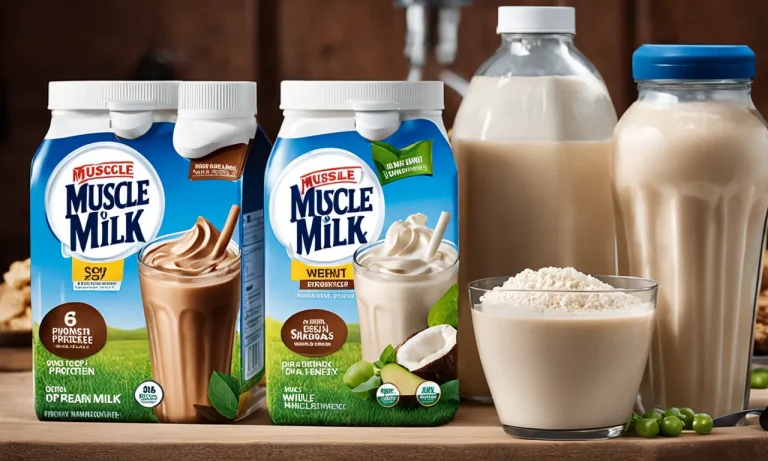Are Natural Flavors Vegan? Deciphering Food Labels
Reading food labels can be confusing for vegans and vegetarians. Ingredients like ‘natural flavors’ are vague and ambiguous. So are these mystery flavors actually vegan-friendly or are they hiding animal ingredients?
In this comprehensive guide, we’ll cut through the confusion surrounding natural flavors and identify which ones are typically vegan and non-vegan.
What Are Natural Flavors?
Natural flavors are a commonly used term in the food industry, but what exactly does it mean? According to the U.S. Food and Drug Administration (FDA), natural flavors are derived from natural sources such as plants, animals, or insects.
These flavors are used to enhance the taste of various food products, including snacks, beverages, and processed foods.
FDA Definition of Natural Flavors
The FDA defines natural flavors as substances derived from plant or animal sources that are used to impart flavor to food. These substances can be obtained through physical processes such as extraction, distillation, or fermentation.
They can also be derived from natural sources through enzymolysis or other chemical processes. It’s important to note that artificial flavors, on the other hand, are chemically synthesized and do not come from natural sources.
How They’re Produced
Natural flavors are produced using a variety of methods. For example, fruits and vegetables can be pressed or squeezed to extract their natural juices, which can then be used as flavoring agents. Herbs and spices can be dried and ground to create powders or extracts.
Some natural flavors are obtained through the fermentation of certain ingredients, such as soy or dairy products.
Additionally, the process of natural flavor extraction often involves the use of solvents, such as water or alcohol, to extract the desired flavors from the source material. These solvents are then evaporated, leaving behind the concentrated natural flavors.
Common Sources: Plants, Animals, Bugs?
Natural flavors can be derived from a wide range of sources, including plants, animals, and even insects. Plant-based natural flavors are perhaps the most common and include extracts from fruits, vegetables, herbs, and spices.
These flavors can provide a wide range of taste profiles, from sweet and fruity to savory and spicy.
Animal-derived natural flavors are less common but still used in some food products. These flavors can come from sources such as beef, chicken, or fish. It’s important to note that these flavors are generally obtained through processes that do not harm or kill the animals.
While it may come as a surprise to some, certain natural flavors can also be derived from insects. In recent years, there has been a growing interest in using insect-derived flavors in food products. For example, cochineal extract, which is derived from a type of insect, is used as a natural red food coloring.
For more information on the FDA’s regulations regarding natural flavors, you can visit their official website here.
Animal-Derived Natural Flavors
When it comes to deciphering food labels and determining whether natural flavors are vegan, it is important to be aware of the various sources from which these flavors can be derived. While natural flavors can be plant-based, there are also animal-derived natural flavors that may not align with a vegan lifestyle.
Dairy Sources Like Casein
One common animal-derived natural flavor is casein, a protein found in milk. Casein is often used to enhance the flavor of dairy products, such as cheese or yogurt. While it may not be immediately obvious, products containing casein are not vegan-friendly.
It is important for those following a vegan diet to carefully read food labels and look for alternatives that use plant-based flavors instead.
Carmine and Other Bug-Based Flavors
Another surprising source of animal-derived natural flavors is insects. Carmine, for example, is a red dye derived from crushed cochineal insects. This dye is commonly used in food products, such as candies and beverages, to give them a vibrant red color.
Vegans who avoid consuming insects may want to be cautious and check for carmine or other bug-based flavors on ingredient lists.
Meat and Fish Flavorings
Some natural flavors are derived from meat and fish sources, which can be problematic for vegans. These flavors are often used to enhance the taste of savory dishes, such as soups, sauces, and snacks. If a product contains natural flavors and is labeled as vegan, it is unlikely to contain meat or fish flavorings.
However, it is always a good idea to double-check the ingredients list to ensure that no animal-derived flavors are included.
It is worth noting that the use of natural flavors in food products can vary from brand to brand. Some companies may choose to use plant-based natural flavors exclusively, while others may incorporate both animal and plant-based flavors.
As a consumer, being knowledgeable about the various sources of natural flavors can help you make informed choices that align with your dietary preferences.
For more information on vegan-friendly food options and decoding food labels, websites like The Vegan Society or PETA can provide valuable insights and resources.
Vegan Natural Flavor Sources
When deciphering food labels to determine if natural flavors are vegan, it’s essential to understand where these flavors come from. While some natural flavors may be derived from animal sources, there are several vegan-friendly options available as well.
Extracts from Fruits and Vegetables
One common source of vegan natural flavors is extracts from fruits and vegetables. These extracts are obtained by processing the fruits or vegetables to extract the desired flavor compounds. For example, vanilla extract is derived from the beans of the vanilla orchid, while citrus extracts are obtained from the peels of oranges, lemons, or grapefruits.
These extracts are typically vegan-friendly and add delicious natural flavors to various food products.
Herbs, Spices, and Essential Oils
Herbs, spices, and essential oils are another source of vegan natural flavors. These flavors are derived from plant materials, such as leaves, stems, seeds, and flowers, and are commonly used to enhance the taste of food.
For instance, the flavor of cinnamon can be extracted from the bark of the cinnamon tree, while peppermint flavor comes from the leaves of the peppermint plant. These vegan natural flavors not only add depth to food but also offer potential health benefits due to the presence of phytochemicals in the plant materials.
Mushroom-Derived Flavors
Mushroom-derived flavors provide a unique and vegan-friendly option for natural flavors. Certain mushrooms, such as shiitake or porcini mushrooms, have rich and savory flavors that can be extracted and used to enhance the taste of various dishes.
These mushroom-derived flavors are often used in plant-based meat substitutes to provide a meaty and umami taste. They are a great choice for those following a vegan diet, as they offer a natural and sustainable alternative to animal-derived flavors.
It’s important to note that while these sources of natural flavors are generally vegan-friendly, it’s always recommended to check the specific ingredients listed on food labels. Additionally, some natural flavors may be processed using non-vegan methods, so it’s best to look for products that are certified vegan or seek out information from reliable sources, such as The Vegan Society or PETA.
Identifying Vegan Natural Flavors
When it comes to deciphering food labels and determining whether natural flavors are vegan-friendly, there are a few key strategies to keep in mind. By contacting manufacturers about sourcing, looking for vegan certification, and learning flavoring terminology, consumers can make more informed choices about the products they purchase.
Contacting Manufacturers About Sourcing
One way to identify vegan natural flavors is by reaching out to manufacturers directly and asking about the sourcing of their flavorings. While this may require some effort, it can provide valuable insight into the ingredients used.
By asking specific questions about the origin of the flavors and whether any animal-derived ingredients are used, consumers can make informed decisions about the vegan-friendliness of a product.
It is important to note that some manufacturers might not disclose their complete ingredient list, as natural flavors may be considered proprietary information. In such cases, it may be helpful to ask for a general statement about whether the natural flavors used are vegan-friendly.
Additionally, some manufacturers may have a dedicated customer service line or email address for inquiries about specific dietary restrictions, making it easier for consumers to get the information they need.
Looking for Vegan Certification
Another way to identify vegan natural flavors is by looking for vegan certification on food labels. Various organizations provide vegan certification to products that meet their specific criteria. These certifications often require that no animal-derived ingredients, including natural flavors, are used in the manufacturing process.
When shopping, look for labels indicating vegan certification from reputable organizations such as the Vegan Society or the Certified Vegan logo. These certifications can offer reassurance to consumers that the natural flavors used in the product are vegan-friendly.
Learning Flavoring Terminology
Understanding flavoring terminology can also be helpful when trying to identify vegan natural flavors. While the term “natural flavors” may seem vague, it typically refers to flavorings derived from plant sources.
However, it is important to be aware that natural flavors can sometimes be derived from animal sources as well.
By familiarizing themselves with common flavoring terms, such as “vanilla extract” or “fruit essence,” consumers can have a better understanding of the ingredients used and determine whether they are vegan-friendly.
Websites like FDA’s Food Labeling Guide or Code of Federal Regulations can provide more information on flavoring terminology and regulations.
Ultimately, identifying vegan natural flavors requires a combination of research, communication with manufacturers, and a clear understanding of flavoring terminology. By utilizing these strategies, consumers can make more informed choices and ensure that their dietary preferences align with the products they consume.
Natural Flavor Alternatives
When it comes to deciphering food labels and determining whether natural flavors are vegan, there are a few alternatives that can be considered. These alternatives give consumers the option to make informed choices based on their dietary preferences and requirements.
Opting for Organic
One alternative to traditional natural flavors is to opt for organic products. Organic foods are made without the use of synthetic chemicals, including artificial flavors. Instead, these products use natural ingredients that are grown in environmentally-friendly conditions.
By choosing organic options, consumers can ensure that the flavors used in their food are derived from natural sources and are suitable for a vegan lifestyle.
Organic products are regulated by various certifications, such as the United States Department of Agriculture (USDA) organic seal. This seal guarantees that the product has met strict standards and does not contain any artificial flavors.
When shopping for organic foods, look for the USDA organic seal on the packaging to ensure its authenticity.
Choosing Artificial Flavors
While natural flavors may not always be vegan-friendly, artificial flavors can serve as an alternative for those following a vegan diet. Artificial flavors are typically made from synthetic compounds that mimic the taste of natural ingredients.
These flavors are often vegan since they do not come from animal-derived sources.
However, it is important to note that artificial flavors may not provide the same nutritional benefits as natural flavors. They are primarily used to enhance the taste of food rather than provide any significant health benefits.
It is always advisable to read the ingredients list carefully and consult with a healthcare professional if you have any specific dietary concerns.
Flavored Extracts
Another alternative to natural flavors is the use of flavored extracts. Flavored extracts are concentrated forms of natural ingredients, such as fruits, herbs, or spices. These extracts can be used to add flavor to a variety of dishes, including baked goods, beverages, and sauces.
When using flavored extracts, it is essential to check the label and ensure that they are made from natural ingredients without any added artificial flavors. Pure extracts are typically vegan-friendly, but it is always best to double-check the ingredients list to be certain.
It’s worth noting that natural flavors can be a complex topic, and it’s always advisable to do thorough research and consult with professionals if you have specific dietary requirements or concerns. Additionally, websites like Vegan Food & Living and PETA provide valuable information and resources for vegans seeking clarification on food labels and ingredients.
Conclusion
The vast majority of natural flavors are vegan, but it takes a bit of detective work to determine their sources. By contacting manufacturers, learning ingredient terminology, and looking for vegan certifications, you can decipher tricky ‘natural flavor’ labels to ensure the flavors align with your dietary preferences.







